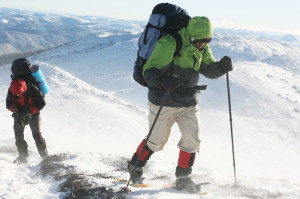Mountain Hiking and How to Get There
Many hikers who are bored of the normal marked trails, and discovered wilderness areas have come to a new adrenaline rush: mountain hiking. Hiking several hundred feet above sea level gives those with a taste for the extreme the rush they are looking for. If you are that kind of hiker, then mountain hiking is for you.
 But wait, before you start day dreaming about the top of the summit, you first need to know how to get there. Mountain hiking isn’t much different than simple hiking. The only major difference is the endurance needed and the terrain you are hiking on. Over all the same gear is needed and the idea is much the same.
But wait, before you start day dreaming about the top of the summit, you first need to know how to get there. Mountain hiking isn’t much different than simple hiking. The only major difference is the endurance needed and the terrain you are hiking on. Over all the same gear is needed and the idea is much the same.
The three layer system that is often used in hiking also applies in mountain hiking. Let’s do this real quick: the layering system offers three different layers of clothing that a hiker should follow.
First is the base layer, which is responsible for keeping a dry and comfortable microclimate next to your skin. For mountain hiking, you can wear two pairs of long johns, top and bottom. The clothes should be made from synthetic fiber but not from cotton.
The second layer you need in mountain hiking is the insulation layer. This layer provides more warmth if the base layer and the shell layer do not provide enough insulation on their own. And last is the shell layer, providing you protection from wind, rain, sleet, snow, etc.
Shirts for mountain hiking during good weather
Wool or fleece sweater or synthetic insulated jacket
Wool shirt or sweater, second fleece/pile jacket, vest, etc.
Fleece pants – side zips are nice as they come in handy if you are getting too hot
While in a typical hiking trip, no more than three layers of clothing is needed, this is not so in mountain hiking, where the conditions can be harsher and more extreme. That is why a fourth layer of clothing is usually added, the ‘super’ insulation layer.
You might need to wear eye protection, depending on where you are hiking. In snowy conditions, blindness is common due to the glare, even on overcast days blindness can be a concern. Also in sunny conditions it is important to wear eye protection to protect your eyes.










